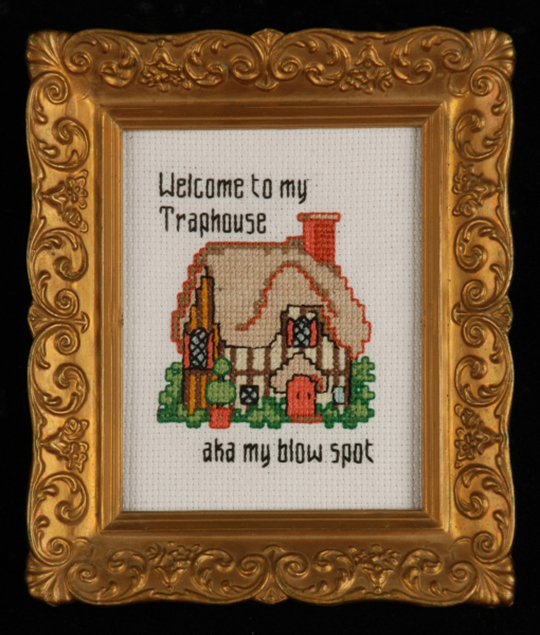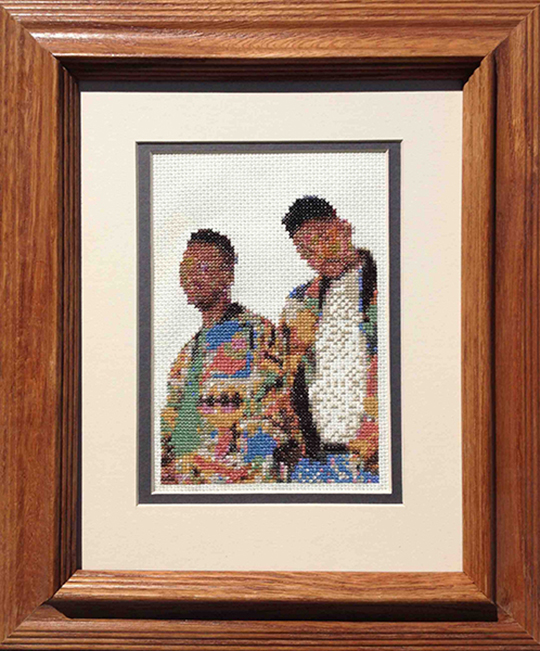Dave Lieske Interview: Hip hop cross stitch art

Through the unlikely combination of hip hop and cross stitch art, Calgary born artist Dave Lieske fuses traditional craftwork and pop culture. Whilst studying at the Alberta College of Art and Design, Dave began to experiment with embroidery and hit upon this novel approach.
In our interview ‘Davey Gravy’ talks about his background in graffiti and how this has influenced his textile art.
Breaking the rules
TextileArtist.org: What initially captured your imagination about cross stitch?
Davey Lieske: Much like tattoos, graffiti, woodworking, etc, there are traditional stylised images that I saw the opportunity to modernise and appropriate. I was very intrigued with the idea of using hundred of small coloured stitches to create a larger image, much like a mosaic. I saw it very accessible because it required very little training and materials.
What or who were your early influences and how has your life/upbringing influenced your work?
In high school I was introduced to the hip hop and graffiti culture. By meeting other like-minded individuals and attending events, I learned that art (in any form) could carry a message. I love the process and guidelines involved in graffiti, where you take a word, add some structure and extensions, add 3D or a drop shadow, then give it a fill and a background. Once you get good at this, you can experiment and break some “rules”. Graffiti has been around for decades, but the pieces and artists that interest me the most are those that take the traditional style and put their own spin on it.
What was your route to becoming an artist? (Formal training or another pathway?)
After high school, I knew I didn’t want to work in an office or go into a trade and decided to give art school a try with the hope of developing my painting and drawing skills while learning some art history. Art school taught me much much more than that. It gave me a chance to give and receive critiques, a space and a time to create, and a place to experiment and try new things without judgment.
Lightheartedness and humor
How would you describe your work and where do you think it fits within the sphere of contemporary art?
It is juxtaposition between traditional cross stitch art/embroidery and contemporary hip hop. I believe it fits in the low-brow, pop surrealism scene. I feel the audience is anyone who buys a cd, picks up a magazine, or flips on the tv. We are so flooded with pop culture that it is difficult to ignore or connect with in some way.
Tell us a bit about the environment you like to work in?
Part of the reason I love cross stitching so much is that it’s portable. I keep whatever piece I’m working on in a Ziploc bag and carry it everywhere in my backpack. My patterns are usually created in my studio where I have all my supplies, frames, and inspiration. When I’m actually stitching, I’ll be parked on my couch in front the TV. The actual stitching portion can be repetitive and I need some background noise.
You’ve taken quite a traditional medium and fused it with very contemporary themes – is this juxtaposition intentional and what is its message?
I don’t want to give away too much of my message, but the juxtaposition is intentional. Pop culture is very specific about gender roles and what a man should look like. Late 90’s and 2000’s hip hop was notorious for depicting men as musclebound tough guys who carried weapons and treated women as sex objects. These are the same rapper’s who are shirtless and oiled up in their music videos which are aimed at a male audience. Hip hop is full of gender role reversal and humor. My work is my interpretation of what I hear and see. I intend to show respect and admiration as well as lightheartedness and humor.
Patience and dedication
How do you seek out subjects for your work?
My subjects are musical artists that I respect and admire their craft. Lately I’ve been trying to work in series; where 2 or more pieces share the same context. Whether its black and white, songs about crime, or borders with flowers, this method helps me create more cohesive pieces, and often pieces that wouldn’t otherwise get made.
Tell us about a piece of work you have fond memories of and why?
One piece I really enjoyed making was “Tha Doggfather”. It was the final piece I made before graduating from art school. It was back before I embraced computer programs to make my patterns. I had ten days to hand make the pattern and complete the stitching. Somewhere in the middle of it I got the flu for two days. The whole piece took me 60-65 hours, I’m happy with how it turned out.
What advice would you give to an aspiring textile artist?
Don’t give up! Textile work is not for everyone, especially those without patience. Patience and dedication are important if you want to create a masterpiece.
Resources
Can you recommend 3 or 4 books for textile artists?
Embroidered Effects: Projects and Patterns to Inspire Your Stitching – Jenny Hart
The New Cross Stitcher’s Bible – Jane Greenoff
Complete Guide to Needlework – Readers Digest
What piece of equipment or tool could you not live without?
My laptop. Patterns can be created in minutes rather than hours. I can digitally store patterns and photos of completed pieces. The internet is a great resource for discovering new artists, different styles of pattern making, and gathering inspiration.
Where can readers see your work this year?
I’m working towards my second solo show and aiming for it to be in Los Angeles. I’m always applying for features in magazines and shows here and there. My work can always be viewed on my website, www.daveygravy.ca, and my Instagram account @davey_gravy.
To find out more about Dave Lieske visit www.daveygravy.ca.
If you’ve enjoyed this interview, why not let us know by leaving a comment below?























Wonderful – thanks Dave for your insights on design inspiration and use of your computer as a design tool. Boy, your needle must have been flying to produce Tha Doggfather in that time! I like what you described about your experimental approach ( what I call the ‘whatif? factor’ ) and your described working environment. I’ve long found a recorded book for sound background is essential to working through the repetitive stages of my work.
Wow just blown away by this artists work.
Loving all of it. Especially the 65 hoir piece.